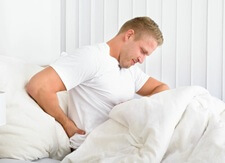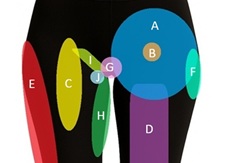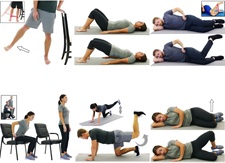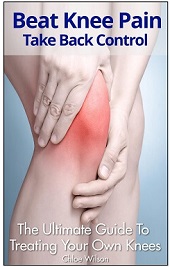- Home
- Hip Pain Diagnosis
- Outer Hip Pain
Outer Hip Pain (Lateral)
Written By: Chloe Wilson, BSc(Hons) Physiotherapy
Reviewed by: KPE Medical Review Board
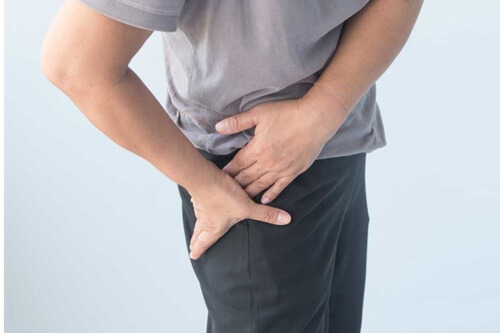
Outer hip pain, aka lateral hip pain, is a common problem that can affect anyone.
It may develop gradually from irritation or repetitive overuse, or suddenly following an injury.
Pain in the outer hip may affect everyday life, walking, running, lying on your side, using stairs, playing sport or work, but there are lots of different things you can do to help. If your pain is further down your leg, check out the outer knee pain article, or have a look at our hip pain diagnosis charts.
Causes Of Outer Hip Pain
There are lots of possible outer hip pain causes which all present slightly differently.
1. Trochanteric Bursitis
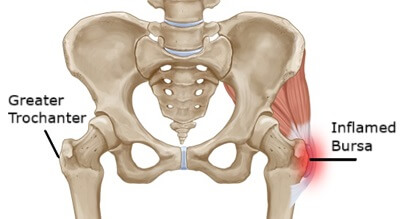
The most common cause of outer hip pain is Trochanteric Bursitis.
This is when excess fluid collects in the trochanteric bursa, located on the outside of the hip. Bursae are small fluid-filled sacs that reduce friction between tissues.
When the trochanteric bursa becomes inflamed, it can cause sharp or burning pain on the outer hip, especially when lying on your side, climbing stairs, or standing up from a chair. It may even affect your sleep.
Trochanteric bursitis is usually caused by repetitive movement, prolonged pressure (like sleeping on that side), muscle tightness or an injury.
Find Out More: Trochanteric Bursitis
2. Hip Impingement
Syndrome
Hip impingement syndrome, aka Femoroacetabular Impingement (FAI), is another common cause of pain in the outer hip.
Hip impingement develops when extra bone grows in and around the hip joint, causing friction during movement. It causes a deep, aching pain in the hip, with episodes of sharp, catching pain when you move the leg.
Symptoms typically get worse after prolonged sitting and are often aggravated by sports or repetitive hip flexion.
Find Out More: Hip Impingement Syndrome
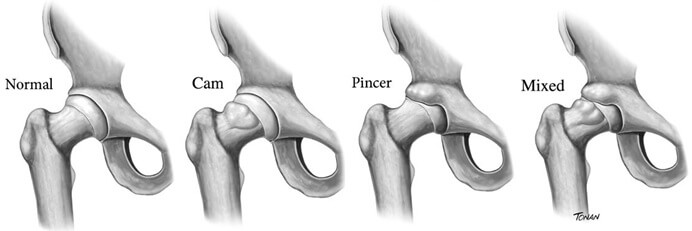
3. IT Band Syndrome
The most common cause of outer hip pain in runners is Iliotibial Band Syndrome (ITBS)
The iliotibial band is a thick band of connective tissue running down the outside of your thig. If it becomes tight or inflamed, it can cause pain on the outer hip, thigh, or even knee.
ITB syndrome usually develops from repetitive friction on the band and is often associated with tightness and weakness. ITB pain on the outer hip is usually worse with running, cycling, squats and hiking.
Find Out More: Iliotibial Band Syndrome
4. Gluteal Tendonitis
Another common cause of outer hip pain is gluteal tendinopathy. Gluteal tendonitis is where there is irritation and degeneration in the tendons that connect to your buttock muscles.
Lateral hip pain from gluteal tendonitis is usually caused by a combination of overuse, muscle imbalance and altered biomechanics. It causes pain in the outer hip which may extend down the outer thigh to the knee especially when walking or standing on one leg. There may be a sharp pain associated with clicking, and feelings of “giving way”.
A painful outer hip from gluteal tendonitis is 4x more common in women than men.
Find Out More: Gluteal Tendinopathy
5. Hip Osteoarthritis
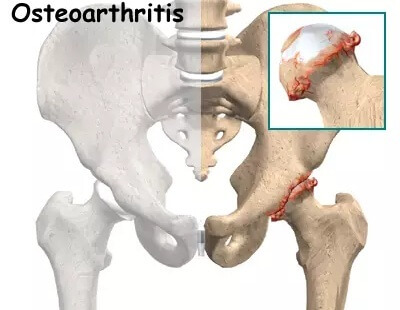
The most common cause of outer hip pain in people over 60 is hip osteoarthritis.
This is when there is degeneration of the cartilage and bone in the hip joint, usually due to aging, wear and tear, or past injury.
Hip arthritis typically causes hip pain and stiffness, particularly after prolonged rest, and is often worse first thing in the morning. There may also be a grinding noise or sensation with leg movements. Whilst the wear and tear in the joint cannot be undone, strengthening exercises can help to reduce the symptoms.
6. Snapping Hip Syndrome
Snapping hip syndrome is a condition where there is a repetitive snapping, popping or clicking sensation or sound when you move the hip.
It is usually caused by tendons or muscles flicking over part of the hip bone. Often the is no pain associated with snapping hip syndrome, but left untreated and can start to cause secondary problems such as bursitis.
Snapping hip usually affects healthy, active individuals who perform repetitive hip movements e.g. dancers, martial arts, soccer players.
Find Out More: Snapping Hip Syndrome
7. Hip Injury or Trauma
A direct fall onto the side of the hip can bruise soft tissues, irritate the bursa, or even cause a fracture in older adults, all of which can result in a painful outer hip.
8. Referred Pain from the Lower Back
Sometimes pain on the outside of the hip isn’t coming from the hip at all. Nerve compression in the lower spine can refer pain into the outer hip or buttock.
Common back problems that can cause lateral hip pain include sciatica, nerve root compression, or degenerative changes in the spine.
Find Out More: Nerve Pain
Symptoms of Lateral Hip Pain
Outer hip pain can feel different depending on the underlying cause, but some common symptoms include:
- Aching or burning pain on the outside of the hip
- Pain when lying on the affected side
- Discomfort when walking, climbing stairs, or getting up from a chair
- Tenderness to touch on the side of the hip
- Stiffness or reduced hip range of motion
- Pain that radiates down the side of the thigh
- Weakness in the leg or hip muscles
If you’re noticing that your symptoms are getting worse over time or interfering with sleep and daily life, it’s worth getting checked out.
Diagnosing Outer Hip Pain
Diagnosis for outer hip and thigh pain usually starts with a good look at your medical history, activity levels, and a physical examination. Your doctor will want to look at:
- Where exactly your pain is
- What movements make it worse or better
- Strength and flexibility of the hip and surrounding muscles
- How your spine and pelvis are functioning
They may be able to make a diagnosis from your history and a thorough medical examination, but in some cases, you may be sent for further tests to find out what is causing your outer hip pain, such as:
- X-rays: to check for arthritis or bone problems
- MRI or Ultrasound: to look at soft tissues like tendons and bursae
- Nerve tests: if referred pain from the back is suspected
It is really important to know what is causing your pain so that you get the right treatment, so accurate lateral hip pain differential diagnosis is really important.
When to See a Doctor
You should see your GP or a specialist if:
- Your outer hip pain is severe or persistent
- You have difficulty walking or bearing weight
- You have swelling or bruising around the hip
- Pain is interfering with sleep
- You have a history of cancer, unexplained weight loss, or night pain
#CommissionsEarned from Amazon on qualifying purchases
Treatment for Pain
in Outer Hip
The good news is that most cases of outer hip pain improve with conservative treatment. Here are some of the most effective treatment options for lateral hip pain:
1. Ice and Anti-inflammatories
Ice packs can reduce inflammation and pain on the outer hip. Apply for 10-15 minutes at a time, every 2-3 hours.
NSAIDs like ibuprofen/Advil can help settle acute flare-ups — always check with your doctor before taking any new medication
2. Activity Modification
Rest for a few days and protect the hip from further injury e.g. by using crutches. Reducing aggravating activities (like lying on your side or climbing stairs) gives irritated tissues time to heal. Avoid high-impact exercise until symptoms ease.
3. Physical Therapy
A tailored rehab program is one of the best ways to treat and prevent outer hip pain, particularly focusing on:
- Hip strengthening exercises including the glutes and core muscles
- Hip stretching exercises for tight structures like the IT band and hip flexors
- Posture and gait correction
- Manual therapy and soft tissue massage to improve hip range of motion
4. Corticosteroid Injections
If your outer hip and thigh pain is severe or persistent, a steroid injection into the bursa or around inflamed tendons can offer temporary relief. These should be used sparingly though as they can cause temporary weakness in the area.
5. Hip Surgery
Surgery is rarely needed for outer hip pain, but in cases of persistent bursitis, tendon ruptures, or hip impingement that don’t respond to conservative care, surgical options might be considered.
For more specific treatment, check out the following articles:
- Trochanteric Bursitis Treatment
- Hip Impingement Treatment
- ITB Syndrome Treatment
- Snapping Hip Syndrome Treatment
Outer Hip Pain Summary
The most common causes of outer hip pain are trochanteric bursitis, gluteal tendinopathy, hip impingement syndrome and ITB syndrome.
Outer hip pain after running is often due to iliotibial band syndrome, hip bursitis, impingement syndrome or gluteal tendinopathy.
Pain in the outer hip that is worse after prolonged rest may be due to osteoarthritis or hip bursitis
Sharp lateral hip pain, particularly with twisting, squatting or pivoting movements often indicates hip impingement syndrome, trochanteric bursitis or if it is severe, may indicate an underlying fracture.
Outer hip pain when lying on your side may be due to trochanteric bursitis, gluteal tendinopathy, ITBS or osteoarthritis and often causes hip pain at night
Pain on the outer hip that is worse when standing on one leg may be due to trochanteric bursitis or gluteal tendonitis.
Outer hip and thigh pain that extends down the leg to the knee or foot, often associated with tingling or numbness, is usually due to a problem in your lower back.
Outer hip pain associated with popping or snapping noise or sensation is usually caused by snapping hip syndrome or a labral tear.
Outer hip pain can be frustrating and limiting, but the right diagnosis and treatment plan can make a world of difference. Whether it is bursitis, tendonitis, or referred pain from your back, addressing the root cause is key to long-term relief.
If you are struggling with pain on the side of your hip, don’t ignore it — the earlier you tackle the problem, the faster you can get back to doing what you love.
You may also be interested in the following articles
- Front Hip Pain
- Inner Thigh Pain
- Top Of Thigh Pain
- Hip Range Of Motion
- Hip Muscle Anatomy
- Outer Knee Pain
- Pain Above The Knee
- Quads Stretches
- Hip Stretches
Related Articles
Hip Pain At Night
October 2nd, 2025
Hip Pain Diagnosis
September 16, 2025
Hip Strengthening
September 24, 2025
Medical & Scientific References
- Lateral Hip Pain: Relation to Greater Trochanteric Pain Syndrome. The Permanente Journal
- Greater Trochanteric Pain Syndrome: A Review Of Diagnosis And Management In General Practice. British Journal Of General Practice
- Lateral Hip Pain in an Athletic Population: Differential Diagnosis and Treatment Options. American Orthopaedic Society For Sports Medicine
- Lateral Hip Pain. Calderdale & Huddersfield NHS Foundation Trust
Last Updated: September 24th, 2025
Next Review Due: September 24th, 2027
